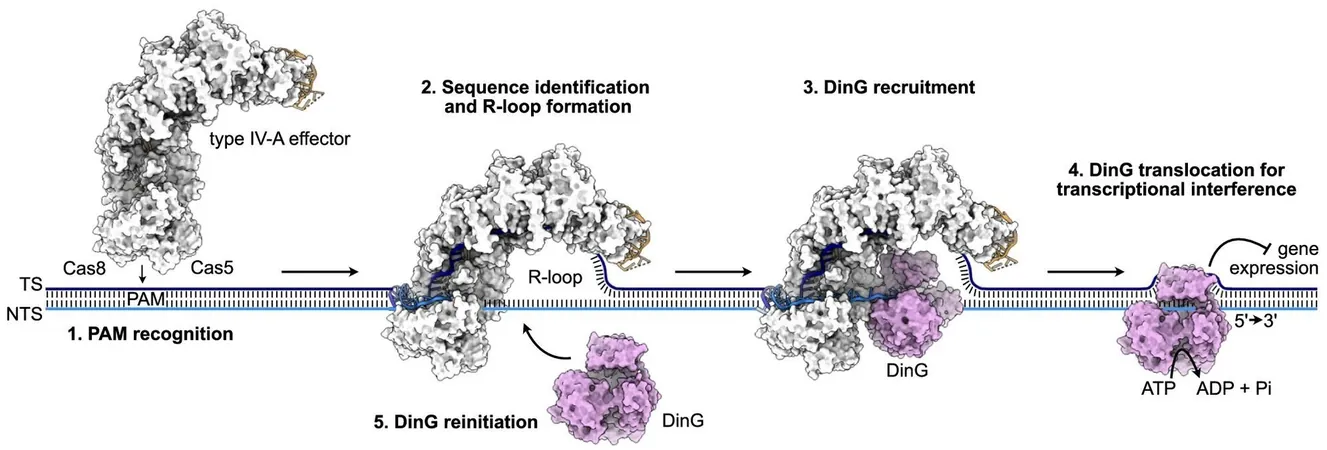
Breakthrough CRISPR System Allows Gene Silencing Without DNA Cutting - A Game Changer in Genetic Research!
2024-11-11
Author: Siti
Introduction
Scientists at Vilnius University’s Life Sciences Center (LSC) have made an astounding breakthrough in genetic research with the discovery of a revolutionary CRISPR system that silences specific genes without resorting to the traditional method of cutting DNA. This groundbreaking research, spearheaded by Prof. Patrick Pausch and detailed in the prestigious journal *Nature Communications*, is being hailed as a 'pause' button for genetic instructions, offering a safer alternative in the realm of gene editing.
Research Team
The team involved in this pioneering work includes doctoral student Rimvydė Čepaitė, Dr. Aistė Skorupskaitė, and undergraduate Gintarė Žvejyte, collaborating with an international research network. Their findings reveal a sophisticated mechanism by which cells can identify and silence unwanted genes, which could pave the way for innovative treatments targeting diseases caused by faulty genes.
New CRISPR Mechanism
Unlike the commonly used CRISPR gene-editing system known for acting as molecular 'scissors,' this new type IV-A CRISPR system utilizes a unique approach. Instead of severing the genetic material, it deploys an RNA-guided effector complex that engages an enzyme called DinG. This enzyme glides along the DNA, effectively silencing the targeted genes through a more refined method.
Precision and Mechanism
Prof. Pausch highlights the system's remarkable precision: 'It intelligently identifies the exact site on the DNA where it needs to act. It employs two proteins, Cas8 and Cas5, to locate a specific short sequence near the RNA guide's complementary target DNA. Upon recognition, these proteins facilitate the unwinding of the double-stranded DNA, allowing for targeted interrogation.'
Role of R-loops
A pivotal part of this gene silencing process is the formation of R-loops—distinct open DNA structures where RNA attaches itself, signaling the system to initiate gene silencing. 'The ‘R’ in R-loop signifies RNA. All DNA-binding CRISPR-Cas systems utilize this structure to explore the DNA sequence and pinpoint the correct target site. Stable R-loops emerge only when there's a strong enough match between the guide RNA and a segment of DNA,' Dr. Pausch explains. This precise interaction is what prompts the system to commence gene suppression.
DinG Enzyme Functionality
The DinG enzyme plays a crucial role in amplifying gene suppression effects by unwinding DNA strands, allowing for sustained interference over longer DNA sequences. This mechanism not only minimizes the risk of undesired genetic cuts but also opens doors for creating more accurate research tools and biotechnological applications.
Future Implications
With the capability to modify genes safely, this newly discovered CRISPR system holds immense potential for future genome editing applications. Prof. Pausch aptly notes, 'The unique capability of our system to traverse DNA without making cuts is both fascinating and promising for advancing gene-editing technologies.' As this groundbreaking research progresses, it is poised to significantly impact the fields of genetic research and therapy, cultivating a future where genetic disorders can be remedied more safely and effectively.
Conclusion
Stay tuned as this revolutionary system continues to unveil new possibilities in the world of genetics!



 Brasil (PT)
Brasil (PT)
 Canada (EN)
Canada (EN)
 Chile (ES)
Chile (ES)
 España (ES)
España (ES)
 France (FR)
France (FR)
 Hong Kong (EN)
Hong Kong (EN)
 Italia (IT)
Italia (IT)
 日本 (JA)
日本 (JA)
 Magyarország (HU)
Magyarország (HU)
 Norge (NO)
Norge (NO)
 Polska (PL)
Polska (PL)
 Schweiz (DE)
Schweiz (DE)
 Singapore (EN)
Singapore (EN)
 Sverige (SV)
Sverige (SV)
 Suomi (FI)
Suomi (FI)
 Türkiye (TR)
Türkiye (TR)